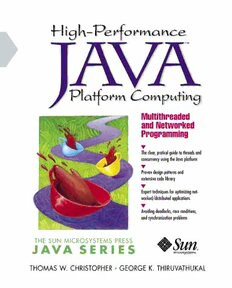Table Of ContentHigh-Performance
Platform Computing
THOMAS W. CHRISTOPHER • GEORGE K. THIRUVATHUKAL
Prentice Hall PTR, Upper Saddle River, NJ 07458 Sun Microsystems Press
www.phptr.com A Prentice Hall Title
.......................................................................................
.......................................................................................
Preface, xv
Acknowledgments, xxi
.................................................................................
Chapter 1
.................................................................................
Foundations, 1
The von Neumann Machine, 2
Flynn’s Taxonomy, 2
Control–Memory Taxonomy, 4
Speedup and Efficiency, 5
Amdahl’s Law, 7
Scalability, 8
Problems of Parallelism, 10
Grain Size, 10
Starvation, 11
Deadlock, 11
v
vi High-Performance Java Platform Computing
Flooding and Throttling, 11
Layout, 12
Latency, 13
Scheduling, 13
Programming Techniques, 15
Chapter Wrap-up, 15
Exercises, 16
.................................................................................
Chapter 2
.................................................................................
Threads, 19
Why is Multithreading Useful? 20
Overview of the Java Threads Classes, 21
Thread: The Class Responsible for Thread Creation and
Execution, 21
Runnable: Making Threads Without Extending the Thread Class, 23
Hello World: A First Example of Multithreading, 25
Implementing Interfaces and Extending Classes: What’s the Deal? 27
Concepts, 28
A Little Bit of History, 29
Some Definitions, 30
Multiprogramming vs. Multitasking, 31
Concurrency vs. Parallelism vs. Distribution, 32
Threads vs. Processes, 33
Kernel-level vs. User-level Threads, 36
Quick Tour of Java Threads Functions, 37
Construction, 37
Daemon Threads, 38
Thread Control, 38
Very Useful Static Methods, 39
Thread Synchronization, 39
Cooperative Multitasking, 40
Prioritized Scheduling, 40
Contents vii
Miscellaneous Status Methods, 41
Methods Not Covered Here, 41
Exercises, 41
.................................................................................
Chapter 3
.................................................................................
Race Conditions and Mutual Exclusion, 43
Know Your Enemy! 44
Race Conditions, 44
Egoist: A First Study in Race Conditions, 44
A Word on Priorities, 46
What is a Race Condition? 47
Race0 Class, 48
Critical Sections and Object Locking, 52
Race1 Class—Fixing Race0 with Synchronization, 53
Conditions, 55
Motivating the Need for Conditions, 55
Key Object Methods Needed to Work with Conditions in Java, 57
File Copying: A Producer–Consumer Example, 58
Locks–Binary Semaphores: An Example of Using Conditions, 68
Race2: Reworked Race1 Using Locks, 71
Classic Synchronization Mechanisms, 73
Counting Semaphore, 73
Barrier, 75
Futures, 76
Deadlock, 78
What is Deadlock? 78
How to Know When Deadlock Has Hit You? 78
Four Conditions of Deadlock, 78
A Classic Example: Dining Philosophers, 79
Chapter Wrap-up, 85
Exercises, 87
viii High-Performance Java Platform Computing
.................................................................................
Chapter 4
.................................................................................
Monitors, 89
Real Monitors and Java Monitors, 89
Class Monitor in the Thread Package, 92
Monitor’s Methods, 94
Interface MonitorCondition’s Methods, 95
Interface MonitorLock, 96
Examples using Monitor Objects, 97
SimpleFuture, 97
SharedTableOfQueues, 98
Implementation of Monitor, Condition, and
MonitorLock, 101
Monitor Entry and Exit, 102
Monitor.Condition, 105
Monitor.Lock, 109
The Multiple Reader–Writer Monitors, 110
Policies, 111
Entering and Leaving the Critical Sections, 112
The Single-Reader–Writer Monitor, 112
The Readers-Preferred Monitor, 113
The Writers-Preferred Monitor, 115
The Alternating Readers–Writers Monitor, 117
The Take-a-Number Monitor, 119
Chapter Wrap-up, 120
Exercises, 121
.................................................................................
Chapter 5
.................................................................................
Parallel Execution of Subroutines in Shared Memory, 123
Creating and Joining, 124
Contents ix
Example: Trapezoidal Numeric Integration, 125
RunQueue, 129
RunQueue Methods, 129
RunQueue Implementation, 133
Recursive Shell Sort: RunQueues and SimpleFutures, 138
Accumulator, 141
Accumulator Operations, 141
Patterns of Use of Accumulators, 142
Using Accumulators, 144
Numeric Integration, 144
TerminationGroup, 147
Combinatorial Search, 149
The 0–1 Knapsack Problem, 149
Parallel Depth-first Search for the Knapsack Problem, 152
Knapsack2, 154
PriorityRunQueue, 159
Branch-and-Bound with Priority Run Queues, 161
Branch and Bound for 0–1 Knapsack, 161
A Purer Branch-and-Bound 0–1 Knapsack, 167
Chapter Wrap-up, 167
Exercises, 170
.................................................................................
Chapter 6
.................................................................................
Parallelizing Loops, 171
Chore Graphs, 172
Gathering Chores into Threads, 174
Example: Warshall’s Algorithm, 174
Static Scheduling, 177
Dynamic Scheduling, 177
Example: Longest Common Subsequence, 184
x High-Performance Java Platform Computing
Example: Shell Sort, 189
Chapter Wrap-up, 194
Exercises, 195
.................................................................................
Chapter 7
.................................................................................
Chores, 197
The RunDelayed Interface, 199
Futures, 199
FutureFactory, 201
Chore-programming Techniques, 201
Job Jars, 202
Chore Graphs, 202
Macro Dataflow, 202
Flow of Control, 206
Macro Dataflow Examples: Vector Addition, 209
Continuations to Separate Operand Fetch from Operation, 210
Static Dataflow Style and Storing Operands in Instructions, 213
Fetching in Continuations, 217
Chore examples: Warshall’s Algorithm, 218
WarshallDF1 and Warshall’s Algorithm in Dataflow, 219
WarshallC1 through WarshallC3: Chores, But Not
Dataflow, 223
Chapter Wrap-up, 236
Exercises, 237
.................................................................................
Chapter 8
.................................................................................
Thread and Chore Synchronization, 239
TerminationGroup, 239
Barrier, 241
Contents xi
BarrierFactory, 243
AccumulatorFactory, 244
Parallel Quicksort, 244
Shell Sort, 248
Chapter Wrap-up, 256
.................................................................................
Chapter 9
.................................................................................
Shared Tables of Queues, 257
Shared Tables of Queues, 258
Methods, 258
Implementing Synchronizations Using a Shared Table of
Queues, 260
Indexed Keys, 262
Implementing More Synchronizations and Shared Structures, 265
Reactive Objects, 268
Communicating through a Shared Table of Queues, 271
Future Queues, 277
Methods, 278
Implementation of FutureQueue, 280
Example of FutureQueue: The Queued Readers–Writers
Monitor, 285
Future Tables, 287
Chapter Wrap-up, 287
Exercises, 288
.................................................................................
Chapter 10
.................................................................................
Streams Essentials, 289
The Streams Abstraction, 290
Building Your Own Stream, 291
xii High-Performance Java Platform Computing
Caesar Cipher: Very Basic Encryption, 299
Chapter Wrap-up, 287
Exercises, 288
.................................................................................
Chapter 11
.................................................................................
Networking, 307
Exploring the Client Side, 308
Services: The Internet Story, 310
Destination Sendmail, 312
Java Networking: Socket and InetAddress, 315
Where Are the Services? 325
A Kind and Gentle Introduction to the Server Side, 334
Iterative Servers, 335
Simple Messaging Architecture, 341
The Message Class, 342
DateService and DateClient SMA Style, 355
Chapter Wrap-Up, 358
Exercises, 358
.................................................................................
Chapter 12
.................................................................................
Coordination, 361
Generic Mailbox Invocations, 362
GMI: Goals and Design Overview, 363
Callable: An Interface for Accepting Communication, 363
CallMessage: An Abstract Class for Marshalling and
Unmarshalling! 364
RemoteCallServer, 365
RemoteCallServerDispatcher, 367
RemoteCallClient, 369
Contents xiii
Memo: A Remote Interface to SharedTableOfQueues, 372
Design, 372
MemoServer, 376
MemoClient, 377
Vector Inner Product, 379
Trapezoidal Integration, 386
Warshall’s Algorithm, 391
Chapter Wrap-up, 398
Exercises, 398
Index, 401

